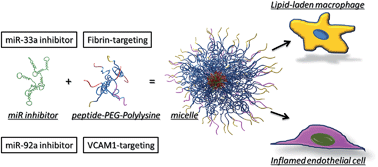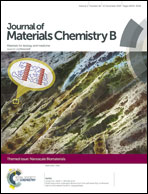Inhibition of atherosclerosis-promoting microRNAs via targeted polyelectrolyte complex micelles
Abstract
Polyelectrolyte complex micelles have great potential as gene delivery vehicles because of their ability to encapsulate charged nucleic acids forming a core by neutralizing their charge, while simultaneously protecting the nucleic acids from non-specific interactions and enzymatic degradation. Furthermore, to enhance specificity and transfection efficiency, polyelectrolyte complex micelles can be modified to include targeting capabilities. Here, we describe the design of targeted polyelectrolyte complex micelles containing inhibitors against dys-regulated microRNAs (miRNAs) that promote atherosclerosis, a leading cause of human mortality and morbidity. Inhibition of dys-regulated miRNAs in diseased cells associated with atherosclerosis has resulted in therapeutic efficacy in animal models and has been proposed to treat human diseases. However, the non-specific targeting of microRNA inhibitors via systemic delivery has remained an issue that may cause unwanted side effects. For this reason, we incorporated two different peptide sequences to our miRNA inhibitor containing polyelectrolyte complex micelles. One of the peptides (Arginine-Glutamic Acid-Lysine-Alanine or REKA) was used in another micellar system that demonstrated lesion-specific targeting in a mouse model of atherosclerosis. The other peptide (Valine-Histidine-Proline-Lysine-Glutamine-Histidine-Arginine or VHPKQHR) was identified via phage display and targets vascular endothelial cells through the vascular cell adhesion molecule-1 (VCAM-1). In this study we have tested the in vitro efficacy and efficiency of lesion- and cell-specific delivery of microRNA inhibitors to the cells associated with atherosclerotic lesions via peptide-targeted polyelectrolyte complex micelles. Our results show that REKA-containing micelles (fibrin-targeting) and VHPKQHR-containing micelles (VCAM-1 targeting) can be used to carry and deliver microRNA inhibitors into macrophages and human endothelial cells, respectively. Additionally, the functionality of miRNA inhibitors in cells was demonstrated by analyzing miRNA expression as well as the expression or the biological function of its downstream target protein. Our study provides the first demonstration of targeting dys-regulated miRNAs in atherosclerosis using targeted polyelectrolyte complex micelles and holds promising potential for translational applications.

- This article is part of the themed collection: Nanoscale Biomaterials

 Please wait while we load your content...
Please wait while we load your content...